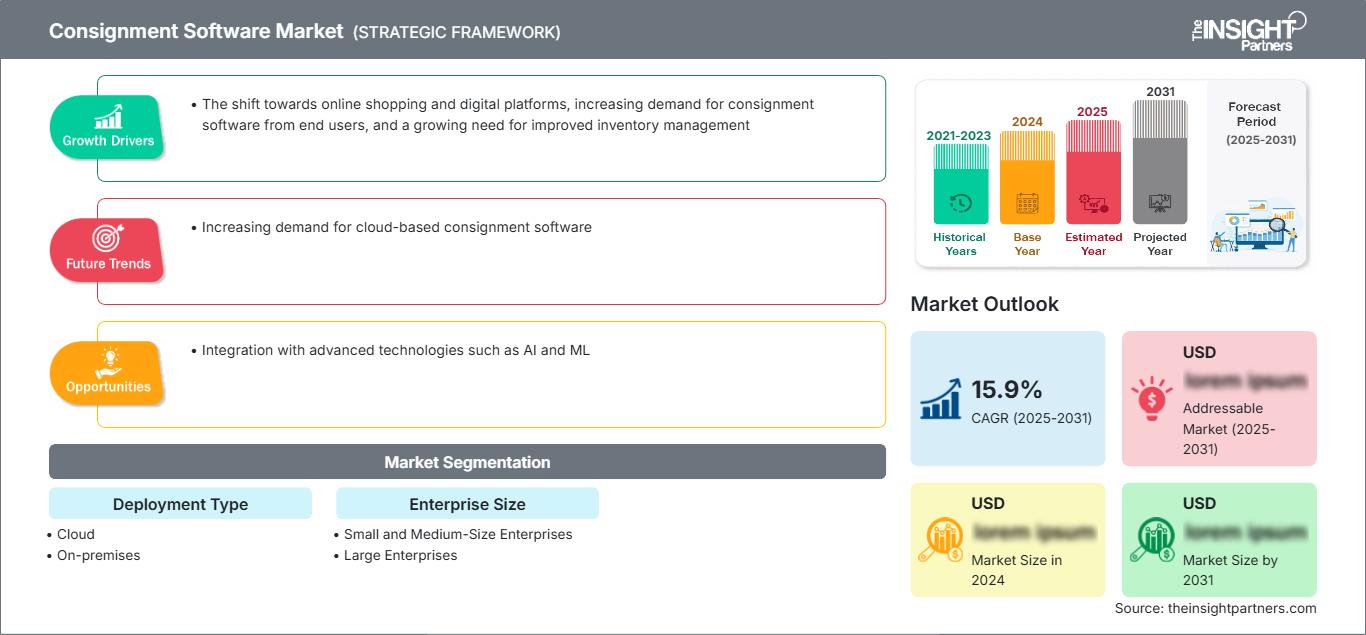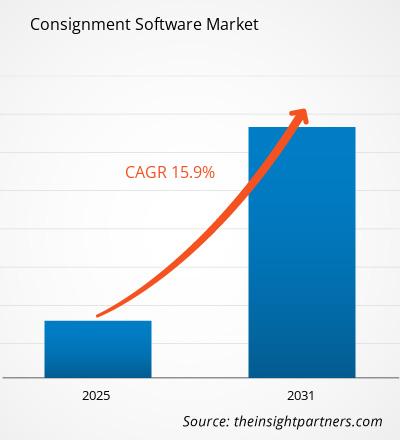Der Markt für Konsignationssoftware wird zwischen 2023 und 2031 voraussichtlich eine durchschnittliche jährliche Wachstumsrate (CAGR) von 15,9 % verzeichnen. Die Integration mit fortschrittlichen Technologien wie KI und ML wird voraussichtlich ein wichtiger Trend auf dem Markt bleiben.
Marktanalyse für Konsignationssoftware
- Der Markt für Konsignationssoftware bietet Wachstumsaussichten aufgrund der aktuellen Markttrends und ihrer vorhersehbaren Auswirkungen im Prognosezeitraum.
- Der Markt für Konsignationssoftware wächst aufgrund von Faktoren wie der Verlagerung hin zu Online-Shopping und digitalen Plattformen, der steigenden Nachfrage nach Konsignationssoftware von Endbenutzern und dem wachsenden Bedarf an verbesserter Bestandsverwaltung.
- Die steigende Nachfrage nach Cloud-basierter Konsignationssoftware bietet lukrative Möglichkeiten für den Konsignationssoftwaremarkt.
Marktübersicht für Konsignationssoftware
- Konsignationssoftware ist Software, die entwickelt wurde, um die Wiederverkaufsbranche zu unterstützen, einschließlich Konsignation, Secondhand-Läden, Einkaufszentren und Secondhand-Geschäften.
- Konsignationssoftware erleichtert die mühelose Verwaltung von Konsignationsgeschäften.
- Konsignationssoftware automatisiert Verkaufsverfolgung, Abrechnungen und Finanzberichte zur Verwaltung von Einnahmen und Ausgaben. Die Echtzeitkommunikation mit den Versendern gewährleistet reibungslose Transaktionen, Zahlungseingänge und die Abwicklung von Rücksendungen oder Umtausch, was zur Verbesserung des Kundenservice beiträgt.
Passen Sie diesen Bericht Ihren Anforderungen an
Sie erhalten kostenlos Anpassungen an jedem Bericht, einschließlich Teilen dieses Berichts oder einer Analyse auf Länderebene, eines Excel-Datenpakets sowie tolle Angebote und Rabatte für Start-ups und Universitäten.
Markt für Konsignationssoftware: Strategische Einblicke

- Holen Sie sich die wichtigsten Markttrends aus diesem Bericht.Dieses KOSTENLOSE Beispiel umfasst Datenanalysen, die von Markttrends bis hin zu Schätzungen und Prognosen reichen.
Treiber und Chancen für den Konsignationssoftware-Markt: Online-Shopping und digitale Plattformen begünstigen den Markt
Sie erhalten kostenlos Anpassungen an jedem Bericht, einschließlich Teilen dieses Berichts oder einer Analyse auf Länderebene, eines Excel-Datenpakets sowie tolle Angebote und Rabatte für Start-ups und Universitäten.
Markt für Konsignationssoftware: Strategische Einblicke

- Holen Sie sich die wichtigsten Markttrends aus diesem Bericht.Dieses KOSTENLOSE Beispiel umfasst Datenanalysen, die von Markttrends bis hin zu Schätzungen und Prognosen reichen.
- Da immer mehr Handel weltweit online stattfindet, setzen die Akteure im Einzelhandel, vom Ladenbesitzer bis zum Lieferanten, nach und nach auf digitale Lösungen.
- Online-Shopping hat den Einzelhandel revolutioniert und die Art und Weise, wie Verbraucher einkaufen und Unternehmen arbeiten, verändert.
- Online-Shopping ist mit dem enormen Wachstum der E-Commerce-Branche und dem technologischen Fortschritt immer beliebter und bequemer geworden.
- Laut Retyp, LLC gab es im Jahr 2022 in den USA 268 Millionen Online-Käufer. Diese Zahl soll bis 2031 auf fast 285 Millionen Online-Käufer ansteigen. Darüber hinaus wird geschätzt, dass es im Jahr 2024 weltweit 12 bis 24 Millionen E-Commerce-Shops geben wird.
- Diese Verlagerung hin zu Online-Shopping und digitalen Plattformen treibt also das Wachstum des Konsignationssoftware-Marktes voran.
Steigende Nachfrage nach Cloudbasierte Konsignationssoftware
- Cloudbasierte Konsignationssoftware bietet verbesserte Zugänglichkeit und ermöglicht es Ladenbesitzern und Mitarbeitern, Bestands- und Verkaufsdaten von jedem Ort mit Internetverbindung aus zu verwalten.
- Cloudbasierte Konsignationssoftware ist aufgrund des abonnementbasierten Modells für kleinere Geschäfte und Start-ups leichter zugänglich, was durch geringere Vorlaufkosten auch die potenzielle Nutzerbasis der Software erhöht.
- Bessere Integrationsmöglichkeiten mit E-Commerce-Plattformen und Zahlungsabwicklern ermöglichen umfassendere Lösungen, während Skalierbarkeit und automatische Updates den IT-Aufwand verringern.
- Die Umstellung auf Cloud-basierte Lösungen dürfte zu einem erheblichen Wachstum des Marktes für Konsignationssoftware führen, da Unternehmen zunehmend die Vorteile dieser modernen, flexiblen und funktionsreichen Plattformen erkennen.
Segmentierungsanalyse des Marktberichts für Konsignationssoftware
Schlüsselsegmente, die zur Ableitung der Marktanalyse für Konsignationssoftware beigetragen haben, sind Bereitstellungstyp und Unternehmensgröße.
- Nach Bereitstellungstyp ist der Markt unterteilt in Cloud und vor Ort.
- Nach Unternehmensgröße ist der Markt in kleine und mittlere Unternehmen sowie große Unternehmen unterteilt.
Marktanteilsanalyse für Konsignationssoftware nach Geografie
- Der Marktbericht für Konsignationssoftware enthält eine detaillierte Analyse von fünf großen geografischen Regionen, einschließlich der aktuellen und historischen Marktgröße sowie Prognosen für 2021 bis 2031 für Nordamerika, Europa, den asiatisch-pazifischen Raum (APAC), den Nahen Osten und Afrika (MEA) sowie Süd- und Mittelamerika.
- Jede Region ist weiter in entsprechende Länder unterteilt. Dieser Bericht bietet Analysen und Prognosen für mehr als 18 Länder und deckt die Marktdynamik von Konsignationssoftware ab, wie z. B. Treiber, Trends und Chancen, die die Märkte auf regionaler Ebene beeinflussen.
- Darüber hinaus umfasst der Bericht eine PEST-Analyse, die die Untersuchung der wichtigsten Faktoren umfasst, die den Markt für Konsignationssoftware in diesen Regionen beeinflussen.
Markt für Konsignationssoftware
Die Analysten von The Insight Partners haben die regionalen Trends und Faktoren, die den Markt für Konsignationssoftware im Prognosezeitraum beeinflussen, ausführlich erläutert. In diesem Abschnitt werden auch die Marktsegmente und die geografische Lage in Nordamerika, Europa, dem asiatisch-pazifischen Raum, dem Nahen Osten und Afrika sowie Süd- und Mittelamerika erörtert.Umfang des Marktberichts über Konsignationssoftware
| Berichtsattribut | Einzelheiten |
|---|---|
| Marktgröße in 2024 | US$ XX million |
| Marktgröße nach 2031 | US$ XX Million |
| Globale CAGR (2025 - 2031) | 15.9% |
| Historische Daten | 2021-2023 |
| Prognosezeitraum | 2025-2031 |
| Abgedeckte Segmente |
By Bereitstellungstyp
|
| Abgedeckte Regionen und Länder | Nordamerika
|
| Marktführer und wichtige Unternehmensprofile |
|
Dichte der Marktteilnehmer für Konsignationssoftware: Verständnis ihrer Auswirkungen auf die Geschäftsdynamik
Der Markt für Konsignationssoftware wächst rasant. Die steigende Nachfrage der Endnutzer ist auf Faktoren wie veränderte Verbraucherpräferenzen, technologische Fortschritte und ein stärkeres Bewusstsein für die Produktvorteile zurückzuführen. Mit der steigenden Nachfrage erweitern Unternehmen ihr Angebot, entwickeln Innovationen, um den Bedürfnissen der Verbraucher gerecht zu werden, und nutzen neue Trends, was das Marktwachstum weiter ankurbelt.

- Holen Sie sich die Markt für Konsignationssoftware Übersicht der wichtigsten Akteure
Der Markt für Konsignationssoftware wird durch die Erhebung qualitativer und quantitativer Daten aus Primär- und Sekundärforschung bewertet, die wichtige Unternehmenspublikationen, Verbandsdaten und Datenbanken umfasst. Einige der Entwicklungen im Markt für Konsignationssoftware sind nachfolgend aufgeführt:
- Entrupy kooperiert mit Consign Cloud. ConsignCloud bietet Funktionen, die genau das vereinfachen: Sie rationalisieren Inventurprozesse, optimieren die Kategorisierung und sorgen für ein reibungsloseres, effizienteres Einkaufserlebnis für Wiederverkaufsexperten im Geschäft. Entropy stellt gleichzeitig sicher, dass das Geschäft mit den richtigen Produkten bestückt ist. (Entrupy, Pressemitteilungen, Februar 2024)
- mymediset, der führende Anbieter von SAP-Lösungen für die Medizintechnikbranche, und Terso Solutions, der führende Anbieter von RFID-Tracking-Lösungen für die Biowissenschaften und das Gesundheitswesen, haben heute eine neue Partnerschaft zur Einführung von mymediset LiveSync bekannt gegeben. Diese revolutionäre Plattform wird die Identifizierung, Verwaltung und Verfolgung von Konsignationsbeständen in unternehmenskritischen Lieferketten weltweit revolutionieren. (Mediaset, Pressemitteilungen, März 2024)
Bericht zum Markt für Konsignationssoftware: Umfang und Ergebnisse
Der „Markt für Konsignationssoftware: Größe und Prognose (2021–2031)“ Der Bericht bietet eine detaillierte Analyse des Marktes und deckt die folgenden Bereiche ab:
- Marktgröße und Prognose für Konsignationssoftware auf globaler, regionaler und Länderebene für alle abgedeckten wichtigen Marktsegmente
- Markttrends für Konsignationssoftware sowie Marktdynamik wie Treiber, Einschränkungen und wichtige Chancen
- Detaillierte PEST/Porters Five Forces- und SWOT-Analyse
- Marktanalyse für Konsignationssoftware mit wichtigen Markttrends, globalen und regionalen Rahmenbedingungen, wichtigen Akteuren, Vorschriften und aktuellen Marktentwicklungen
- Branchenlandschaft und Wettbewerbsanalyse mit Marktkonzentration, Heatmap-Analyse, prominenten Akteuren und aktuellen Entwicklungen für den Markt für Konsignationssoftware
- Detaillierte Unternehmensprofile
- Historische Analyse (2 Jahre), Basisjahr, Prognose (7 Jahre) mit CAGR
- PEST- und SWOT-Analyse
- Marktgröße Wert/Volumen – Global, Regional, Land
- Branchen- und Wettbewerbslandschaft
- Excel-Datensatz
Aktuelle Berichte
Verwandte Berichte
Erfahrungsberichte
Grund zum Kauf
- Fundierte Entscheidungsfindung
- Marktdynamik verstehen
- Wettbewerbsanalyse
- Kundeneinblicke
- Marktprognosen
- Risikominimierung
- Strategische Planung
- Investitionsbegründung
- Identifizierung neuer Märkte
- Verbesserung von Marketingstrategien
- Steigerung der Betriebseffizienz
- Anpassung an regulatorische Trends




















 Kostenlose Probe anfordern für - Markt für Konsignationssoftware
Kostenlose Probe anfordern für - Markt für Konsignationssoftware